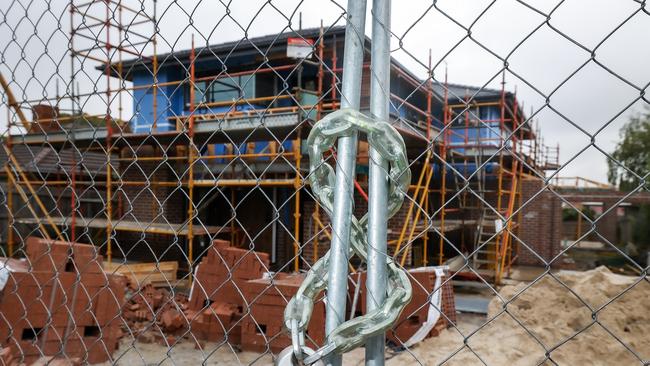Construction quagmire, Porter Davis collapse spark calls for government action
More builders are set to fail, and government may need to step in with stimulus to save the sector, industry watchers say.

Top executives in the construction industry expect more building operators will go broke due to “terrible” conditions in the sector with the collapse of Porter Davis prompting warnings that governments must act to prevent more companies going to the wall.
Porter Davis called in liquidators Grant Thornton on Friday, leaving 1700 homes incomplete in Victoria and Queensland, and sparking concerns about wider contagion as subcontractors and lenders will also be hit.
Builders are worried their operations are no longer viable as costs continue to blow out, interest rate rises are yet to pause, and the existing labour force can’t handle the high volume of often profitless work.
Hutchinson Builders chairman Scott Hutchinson described conditions as “terrible”. “It’s ridiculous. I have never seen it like this. There will be more builders going broke,” he said.
He is sceptical about the prospects of governments being able to save failing builders.
“There’s nothing governments can do. People simply should not build. Governments will fill the gap with infrastructure spending but I don’t think there should be any private building,” he said.
Hutchinson is Australia’s largest private builder and is the country’s third largest residential builder with its focus solely on apartment construction.
Mr Hutchinson said the company will make no money this year but they will be protected by a strong balance sheet.
“What happened is a rush of work came in. Prices have gone up and there’s not the labour force to handle it,” he said.
“It’s completely overheated, especially on the Gold Coast, which we think may be heading for a crash.”
AVJennings chief executive Phil Kearns said the land developer was starting to see input prices flatten but noted that labour shortages remained. “It is difficult to get trades,” he said.
Mr Kearns said that interest rate rises had killed the market with buyer inquiry for new homes slumping due to the uncertainty generated by constant hikes. “The RBA must live in a parallel universe because we see from inquiry levels, right across the market, it’s killing the market off,” he said.
While the land developer is able to push ahead with its projects, he said banks were demanding presales for high-rise projects which was pushing back many towers. “The main panacea to fix it is interest rate stabilisation,” he said, adding a warning about the fragile state of the building industry.
“I think you’ll see more Porter Davises down the line which is not good for anyone,” he said.
Building industry figures are hopeful that conditions will pick up later this year with the country’s largest home builder expecting a return to volumes before the coronavirus crisis.
Metricon chief executive Peter Langfelder said he believed 2023 will be more stable as housing demand comes off unprecedented levels.
“Sales of new homes have slowed, however Metricon is still expected to continue to contract a high number of homes, with forecast figures aligning with pre-pandemic levels,” he said. “This slowing in sales will flow through to a slowdown in building activity in the second half of 2023, this will help to reduce the current labour shortages.
He acknowledged that impact of recent builder collapses which have left about 4500 homes incomplete nationally on buyers.
“We recognise that the current landscape has impacted buyer confidence, so we have listened and responded by offering more flexibility, to better suit the environment we are in and inject more optimism into the market. What we need to see is completions exceeding housing starts,” the housing chief said.
Mr Langfelder said the continued support of the government in addressing the labour skills shortage was appreciated and was an ongoing challenge for the industry.
“Material shortages are no longer an issue and we expect that, with labour challenges also easing, our entire supply chain issue constraints will be much less problematic across the next 12 months,” he said.
“The skills shortage is certainly profound but not new. We are dealing with the most severe skills shortage on record. The return of skilled migration will ease the skills shortage over time, together with building activity beginning to slow, but we have had a shortage of skilled trades for twenty years. Attracting people to the industry is the real challenge,” he said.
This could help kick start the industry. “The migrants that arrive will need housing so this will flow through to opportunities for developers and builders,” Langfelder said.
BIS Oxford Economics senior economist Maree Kilroy warned that conditions were so tough that government intervention may be required to avoid the economic fall out from builders folding, which cascades through the economy as it also hits suppliers and subcontractors.
“The overhang of fixed-priced contracts signed when input prices were significantly lower and delays that are pushing out payment milestones continue to make it a difficult environment for builders,” Ms Kilroy said.
She also expects more firms to fail as new home sales remain tough. “Both profitability and cashflow are being challenged, which is echoing through in a rising rate of administrations that will continue this year,” she said, noting this might prompt governments to act.
“Previous downturns have triggered government stimulus, both at the federal and state level. In part, backed by growing community concerns surrounding housing affordability, there is a growing prospect of government intervention this cycle, both to ensure that houses already on the books are completed and to patch over the slump in new sales that will hit ground-level in 2024. Without such action, a steeper and more protracted downturn is a distinct possibility,” Ms Kilroy said.
Australian Construction Industry Forum executive director Dr James Cameron warned of the broader implications of the home builder’s collapse, and called on governments to aid the stressed sector to avoid deepening the housing crisis.
“The news on Friday of home builder Porter Davis going into administration is an absolute tragedy for the clients, employees, subbies and suppliers of Porter Davis, and for the industry more widely,” he said.
“It shows the strain that the industry is under with rising interest rates, and labour and materials costs. Home builder insolvencies will exacerbate the national housing and homelessness crisis, and we urge state and federal governments to intervene to assist residential builders, and thus also their clients and employees,” he said.
Master Builders Australia CEO Denita Wawn said that rising interest rates and declining sales for new home construction was weakening the pipeline of new housing.
She said that the inextricable ties between construction activity and the broader health of the economy were on display in the current environment.
“The government needs to take the necessary steps to ensure interest rates do not need to rise any further and take some of the heavy lifting of our correction off mortgage holders and business owners. From here, there are no easy choices,” Ms Wawn said.
“There is no silver bullet; this will take a concerted effort by all levels of government working in collaboration with industry,” she said.


